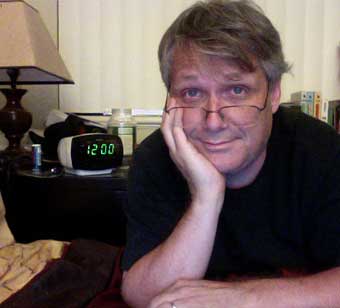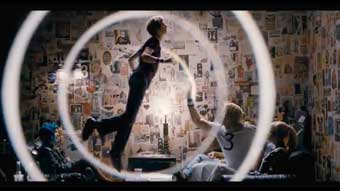And Now I’m 50
 As of a minute ago.
As of a minute ago.
 So a few years ago I did an interview which wound up on the Hellboy 3-Disk DVD. The interview was pretty good (although the “examples” they showed had nothing to do with what I was saying).
So a few years ago I did an interview which wound up on the Hellboy 3-Disk DVD. The interview was pretty good (although the “examples” they showed had nothing to do with what I was saying).
Anyway, it came out, some people bought it, and from its Amazon ranking, it still sells from time to time.
But…
Like all movies, it wound up on sharing/streaming sites. Now, when I egosurf, I see references to the piece all the time, and I know they’re all bootlegs because they’ve apparently been translated into other languages and then translated back.
Just a few of the names:
A Expeditiously Guide to Thought Comics with Scott McCloud
A Fleet Guide to Concept Comics with Scott McCloud
A Fast Guide to Belief Comics with Scott McCloud
A Hastily Guide to Conception Comics with Scott McCloud
A Lickety-split Guide to Conception Comics with Scott McCloud
A Like A Flash Guide to Notion Comics with Scott McCloud
A Mercurial Guide to Idea Comics with Scott McCloud
A Posthaste Guide to Opinion Comics with Scott McCloud
A Rapidly Guide to Idea Comics with Scott McCloud
A Snappy Guide to Plan Comics with Scott McCloud
A Speedily Guide to Idea Comics with Scott McCloud
A Swiftly Guide to Plan Comics with Scott McCloud
I’ve always held back from vilifying file-sharing like some of my peers who work in the “content” industry. I’m a boy scout myself—nearly all my songs and videos are straight from iTunes or equivalent sources—but I would rather live in a world that allows sharing and tries to build markets from willing sellers and willing buyers, than a world where the Net is so controlled that it can be effectively shut down.
Still, it’s sobering to see the scale of the phenomenon and how rarely these sessions pull up the actual name of the original segment:
A Quick Guide to Understanding Comics with Scott McCloud
Been reading and enjoying two very different autobiographical comics; Tracy White’s memoir GN How I Made It to Eighteen and Lea Hernadez’s Near-Life Experience entries at LJ.
White’s book delivers literally on the title, detailing her recovery from mid-teen traumas, and how treatment helped her to not die before becoming the successful and accomplished adult she is today. And like her webcomics at traced.com, How I Made It to Eighteen is “guaranteed 95% true.” She’s changed names and details, but you know you’re getting the facts that matter.
Hernandez’s NLEx also struggles with those 5% quandries, in her case because she’s not writing about events and friends from decades ago, she’s writing about stuff that happened Tuesday, and about a family that might be in the next room. You can feel the inner struggle as she writes about how much she’s willing to write about her son’s ongoing struggles to fit in to society’s limited expectations of him.
It’s a real open question whether any autobiography can ever be more than 95% true. Mark Twain stipulated that his memoir not be published until 100 years after his death (this year!), presumably so that he could be 100% honest—a full implementation of the Mystery Quote—but from what I’ve heard, the old guy doesn’t come across as particularly objective while ranting about his many late-in-life grudges.
Emotional honesty and factual accuracy aren’t the same thing after all. Twain may have thought he was hitting 100%, but maybe nobody can ever get past 95%. And maybe saying so upfront, as White and Hernandez both do in their own fashion, is the most honest way to start.
Running late this morning, so just time for a quick one.
Paul Laroquod points to an interesting Scientific American article about the history, influence, and value of simplified line art and its relatives. Along the way, they point out a correlation between great line artists and lazy eyes.
Art Spiegelman has been saying for years that his own impaired vision in one eye probably influenced his own 2-D world of comics and art, but I doubt he ever expected science to back him up.
Registration is now open to host an event for 24 Hour Comics Day 2010. ComicsPro has general information here and I have more background on the phenomenon here.
Incredibly, this year marks the 20th anniversary of the first 24-hour comic, and the 7th annual 24HCD. I’m old!
Here’s an elegant variation on some spatial ideas that’ll be familiar to regular readers (at least the theory nerds among you).
I liked it a lot. You might too.
Thanks to Rachelle for the pointer.
Alan Rose checks in via email with a link to his memoir comic L’il Rose of Corn, a Sunday Paper-style strip about growing up in Nebraska, complete with newsprint colors to complete the illusion that it’s been printed (it hasn’t—yet).
I was impressed by the confidence and craftsmanship of both writing and art on display. It has a classic feel to it; bolstered by the simple fact that Alan’s stories are genuinely interesting.
In his email Alan shared a great quote attributed (perhaps wrongly) to H. L. Mencken about the great Nebraska-based writer Willa Cather: “I don’t care how great of writer she is, nobody wants to read about Nebraska.”
After reading Rose’s memoir comic, I’ll upgrade “nobody” to “one” at least.


First of all, you knew I would link to the new Scott Pilgrim Trailer, so here it is (link via everyone on Earth).
Also in the news [via The Beat in my case] is a teaser trailer by Dash Shaw and Frank Santoro for an animated feature-to-be called The Ruined Cast (co-produced by John Cameron Mitchell who, I discovered a few years back, looks a bit like Ron Regé when not in Hedwig make-up, but that’s neither here nor there).
Funny thing is, when looking at the two trailers rubbing shoulders in their separate browser tabs, and considering how different they were, I realized there was a big part of my old ’80s-era lizard brain that wanted to label them “mainstream” and “alternative”—even though those terms have mutated beyond recognition in the last ten years.
After all, O’Malley’s comic, for all its rabid fans, is hardly the X-Men (and Edgar Wright is hardly James Cameron). The Scott Pilgrim movie is more geared to “mainstream audiences” than Shaw and Santoro’s project, but both have their roots in what my generation would have unhesitatingly championed as independent sensibilities.
Maybe, the best way for me to get a handle on what “mainstream” means is to just go to what I assume is the root of the term and look to see where the money flows like a big river; and know that rivers split all the time.
I’m taking a day off from blogging since it’s a holiday here in the U.S. and I really need to re-arrange the studio this morning.
I should just say “Happy Memorial Day” and be done with it, but that sounds disrespectful considering the purpose of the holiday, so you’ll have to substitute your own adjective.
See you tomorrow.
Okay, it has nothing to do with comics, but wow, what a great performance. We’re talking me watching on an iPhone at a Payless Shoe Store and getting a tear in my eye. Seriously. Janelle Monáe. Janelle Monáe. Janelle Monáe. Damn…
Anyway, I was talking to our friend Matt yesterday about death music (note change of subject, since the above video is 100% LIFE) and he volunteered Radiohead’s “Pyramid Song” before I could, but that one is definitely on the list. Got me thinking again about my own short list of death songs.
By “death songs” I don’t mean songs with lyrics about death, or music with a morbid style. I mean music that takes you right to edge of what-it-is-to-die. Existentially transportive songs, if that makes any sense.
On my list:
“River Man” by Nick Drake
“Pyramind Song” by Radiohead
“Meeting Across the River” by Bruce Springsteen
“Wayfaring Stranger” The Charlie Haden Quartet West
“Old Man” by Randy Newman
Chopin’s Nocturne in C Sharp Minor (personal connection there)
Purcell’s “Man that is Born” from the Funeral for Queen Mary
The theme for NPR’s “Selected Shorts.” Not sure why.
What’s on your list?